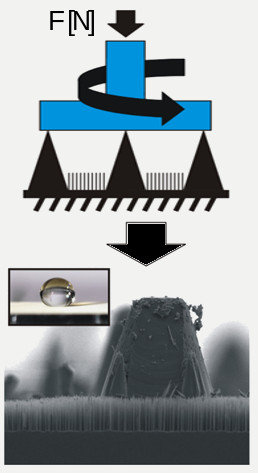Mechanically stable superhydrophobic surfaces
Langmuir just published an important aspect of Vitaliy Kondrashov's work on superhydrophobic surfaces. He combined two variants of the dry reactive ion etching (DRIE) process to generate surfaces with roughness features at two length scales. These features together with a fluoropolymer coating provide superhydrophobic surfaces that can take quite some shear load and still retain their wetting properties.
 The hierarchical structures of these surfaces were fabricated using mask-free dry etching processes. The microcones were obtained through a cryogenic deep reactive ion etching (DRIE) process run in the overpassivation regime. By varying process parameters, surfaces with different microcones geometries and densities were achieved. The nanograss was subsequently fabricated using a modified DRIE process with alternating etching and passivation cycles (’BOSCH process’).
The hierarchical structures of these surfaces were fabricated using mask-free dry etching processes. The microcones were obtained through a cryogenic deep reactive ion etching (DRIE) process run in the overpassivation regime. By varying process parameters, surfaces with different microcones geometries and densities were achieved. The nanograss was subsequently fabricated using a modified DRIE process with alternating etching and passivation cycles (’BOSCH process’).
All surfaces were covered with a layer of a fluorinated film so that superhydrophobic structures resulted.
Depending on microcone geometry and density, the advancing contact angle ranged between 170° and 180°, and roll-off angles of 10 µl drops were measured to be between 30’ (0.5°) and 6°. Various shear loads were applied and the changes in the morphology were recorded by using electron microscopy. The wetting angles of the mechanically challenged surfaces were recorded and correlated with the mechanical properties of the samples.
Vitaliy Kondrashov, and Jürgen Rühe
Microcones and Nanograss: towards mechanically robust superhydrophobic surfaces
Langmuir, 2014,30 (Just accepted manuscript).
DOI: 10.1021/la500395e

